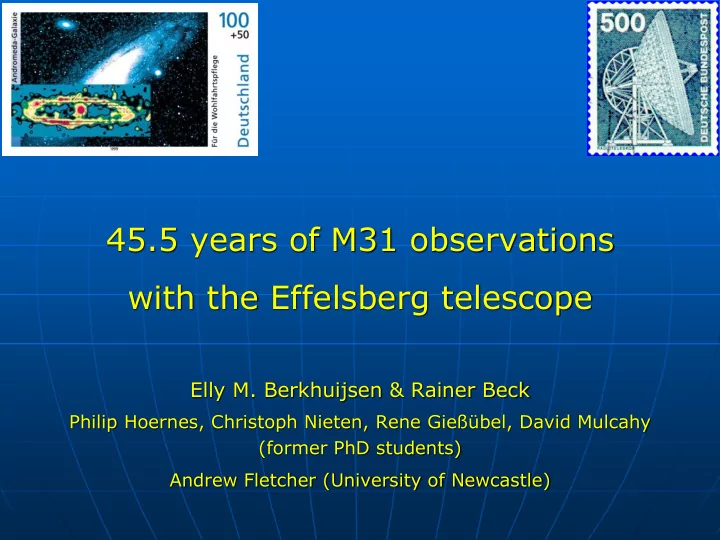

45.5 years of M31 observations with the Effelsberg telescope Elly M. Berkhuijsen & Rainer Beck Philip Hoernes, Christoph Nieten, Rene Gießübel, David Mulcahy (former PhD students) Andrew Fletcher (University of Newcastle)
M31 HI Westerbork Braun et al. 2009
Why M31? Largest spiral galaxy on sky (2 o – 6 o ) Good spatial resolution achievable with the Effelsberg 100-m telescope High declination allows long observation sessions Best-studied spiral galaxy Exceptionally regular magnetic field structure Prototype of a dynamo-generated magnetic field M31 will determine the fate of the Milky Way
First radio "image" of M31 158.5 MHz Jodrell Bank (Hanbury Brown & Hazard 1951)
Most radio continuum surveys of M31 were made with the Effelsberg 100-m telescope
First scan measurements in Effelsberg at 11.1 cm (Berkhuijsen & Wielebinski 1973)
First radio maps from Effelsberg at 11.1 cm and 6.2 cm (Berkhuijsen et al. 1977 & 1983) Background sources subtracted
IAU Symposium No.77 1977 Aug. 22-26 Bad Münstereifel
First detection of polarized radio emission in M31 Effelsberg 11.1 cm (4.5’ or 1.0 kpc resolution) Rainer Beck, PhD Thesis 1979 Up to 45% polarized
First detection of polarized radio emission in M31 Effelsberg 11.1 cm Beck et al. 1978, 1980
First painting M31 in colour at Landesmuseum Bonn
Public attraction Sky & Telescope
The whole galaxy in one run: New broad-band receiver at 6.2 cm Total intensity + B-vectors (corrected for Faraday rotation in the Milky Way foreground) Philip Hoernes, PhD 1996 Background sources subtracted
Circulation: 6.15 million !
Combined efforts: VLA + Effelsberg 20.1 cm (resolution 45" or 170 pc) Beck et al. 1998 Background sources subtracted
VLA + Effelsberg 20.1 cm Thermal + Nonthermal (resolution 45" or 170 pc) Tabatabaei et al. 2013 Nonthermal emission is much smoother
VLA + Effelsberg 20.1 cm Thermal + Nonthermal Berkhuijsen et al. 2013 Synchrotron – FIR correlation is much flatter than thermal – FIR correlation → Cosmic rays diffuse over lengths of 1-2 kpc
Three recent Effelsberg surveys: 2645 MHz (11.1 cm) 4850 MHz (6.2 cm) 8350 MHz (3.6 cm)
Enlarged field: Effelsberg 8-channel system at 11.1 cm Total intensity + E+90° vectors (5' or 1.1 kpc resolution) David Mulcahy, Master Thesis 2011 Strong Faraday rotation Background sources subtracted
Effelsberg broad-band receiver at 6.2 cm Total intensity + E+90° vectors (3' or 680 pc resolution) Rene Gießübel, PhD Thesis 2012 Faraday rotation still significant
Polarized intensity at 6.2 cm + E+90° vectors Effelsberg Rene Gießübel, PhD Thesis 2012 Extent of the ordered field out to ≈ 20 kpc
High frequency: Effelsberg broad-band single-horn receiver at 3.6 cm Total intensity + E+90° vectors (1.5' or 340 pc resolution) Rene Gießübel, PhD Thesis 2012 Small Faraday rotation
Radio emission components and scale lengths at 6.2 cm (3' resolution) Berkhuijsen & Beck, in prep. Large scale lengths: Evidence of cosmic-ray diffusion
Equipartition magnetic field strengths Berkhuijsen & Beck, in prep. Total magnetic field strength: 4-8 μ G Magnetic energy density similar to that of the kinetic turbulent motions, larger than the thermal energy density Ordered field has the largest scale length
Spectral index 20.1/3.6 cm VLA/Effelsberg (90" or 340 pc resolution) Berkhuijsen & Beck, in prep. Flat spectral index in star-forming "ring" due to thermal emission
Synchrotron spectral index 20.1/3.6 cm (90" resolution) Berkhuijsen & Beck, in prep. Cosmic-ray electrons in the "ring" are younger (flatter energy spectrum)
Old Faraday rotation measures 6.2/11.1 cm Effelsberg (5' or 1.1 kpc resolution) Berkhuijsen et al. 2003, Fletcher et al. 2004 Axisymmetric spiral field generated by a mean-field dynamo
New Faraday rotation measures 6.2/11.1 cm Effelsberg (5' or 1.1 kpc resolution) Berkhuijsen & Beck, in prep. rad/m 2 Axisymmetric spiral field confirmed
Polarized intensity 11.1 cm + B-vectors (corrected for Faraday rotation) Effelsberg (5' or 1.1 kpc resolution) Berkhuijsen & Beck, in prep. Magnetic field NOT perfectly aligned along the "ring"
New Faraday rotation measures 3.6/6.2 cm Effelsberg (2.6' or 590 pc resolution) Berkhuijsen & Beck, in prep. rad/m 2 Similar RM pattern, but larger RM values
New Faraday rotation measures 3.6/6.2 cm along the "ring" (Berkhuijsen & Beck, in prep.)
Polarized intensity 6.2 cm + B-vectors (corrected for Faraday rotation) Effelsberg (2.6' or 590 pc resolution) Berkhuijsen & Beck, in prep. Magnetic field NOT perfectly aligned along the "ring"
M31 at 130 MHz LOFAR HBA (200" or 760 pc resolution) Horneffer & Beck, in prep.
The power of the Effelsberg 100-m telescope for continuum mapping Flexible scanning modes No missing large-scale structures Excellent sensitivity to detect weak diffuse emission Large objects can be mapped Excellent performance for linear polarization Best performance between 5 and 15 GHz Receiving systems have excellent stability Multi-horn systems reduce weather effects Advanced processing software (NOD3)
Wishlist Digital polarimeter for continuum mapping (in test phase) (for wide-band polarimetry and RM Synthesis) More horns for X band (8-9 GHz) and/or C/X-band (4-9 GHz) (to reduce weather effects) New multi-horn broadband system for Ku band (12-18 GHz) (to obtain high-resolution maps of galaxies with high surface brightness)
Crash in about 5 billion years
Recommend
More recommend